Table of Contents
Many beekeepers complain about the dreadful wax moth and the damage these creatures do to bee hives, lamenting the destruction of their hives and comb by that sneaky Lepidoptera (butterflies and moths).
It is often a revelation for new beekeepers to learn that wax moths are not guilty of the death of honey bee colonies. They are, in fact, a messy and destructive clean-up crew; opportunists taking advantage of already weakened colonies of honeybees. Wax moths are comparable to vultures or other scavengers.
While it is heartbreaking to see the damage a wax moth infestation can do to stored comb, it is also important to understand that if they are in a live hive, they are probably there because something else is already wrong.
A strong and healthy bee population will control wax moths on their own.
When You Find Wax Moth Damage
Wax moth problems are a warning sign that something else has also gone awry, but an occasional moth is no cause for alarm. A strong colony will fend them off, while a weak colony will succumb to their destruction.
It’s common to find a wax moth infestation after the colony has been dead for some time and the hive hasn’t been opened in weeks or months. The adult wax moths look just like regular moths, and when they find a dead or dying colony, they quickly take advantage.
Because these moths don’t reproduce in freezing weather, it’s common to find wax moth damage after the summer’s end, before winter. Or if you live in a place with very mild winters, you will find the damage in the early spring.
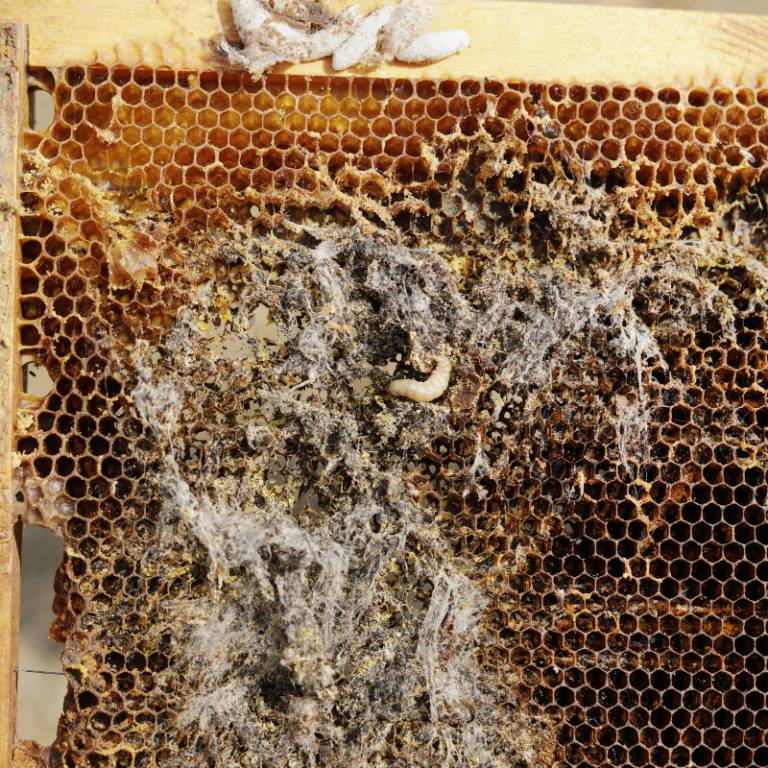
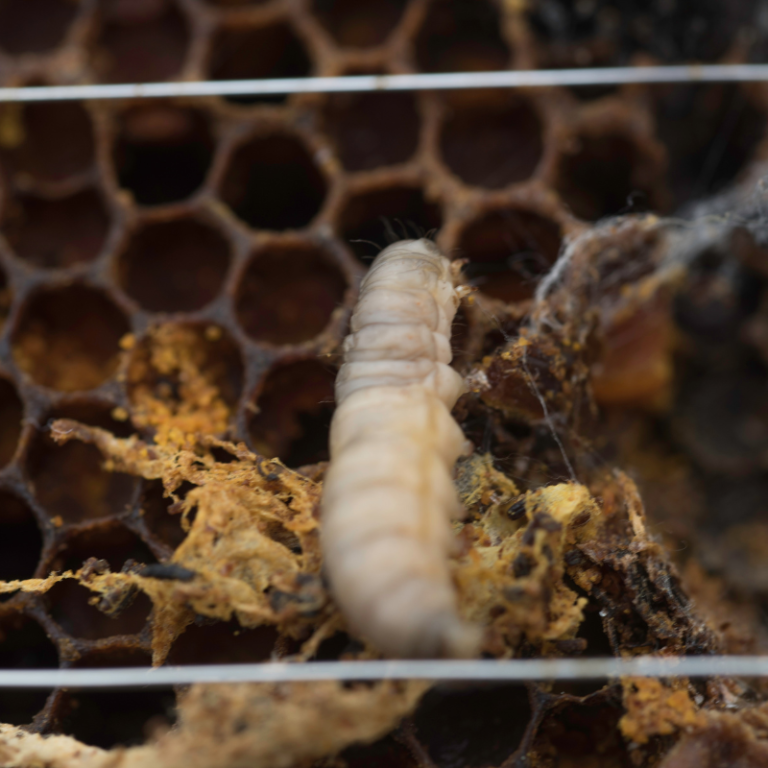
What Are Wax Moths?
There are two species of wax moths: the Greater wax moth and the Lesser wax moth. Greater wax moths are larger and tend to congregate, causing the most damage, while the Lesser wax moth is often solitary.
Adult moths can smell beeswax from a great distance and the female wax moth will enter a hive at night to lay eggs in small, dark crevices.
In nature, wax moths benefit wild honeybee colonies by cleaning up old diseased comb in hollow trees. In this way, they create a fresh and clean space for a new colony to build.
When the wax moth eggs hatch inside the hive, the larvae will tunnel through the comb, eating wax, pollen, bee cocoons and leaving frass (poop) and webs in their wake.
Sometimes the webs can block bee pupae from hatching, or the tunnels through their cells can cause new bees to be deformed or to die, and worker bees will carry them out. You’ll see them at the front door, and you’ll know that you need to take a look.
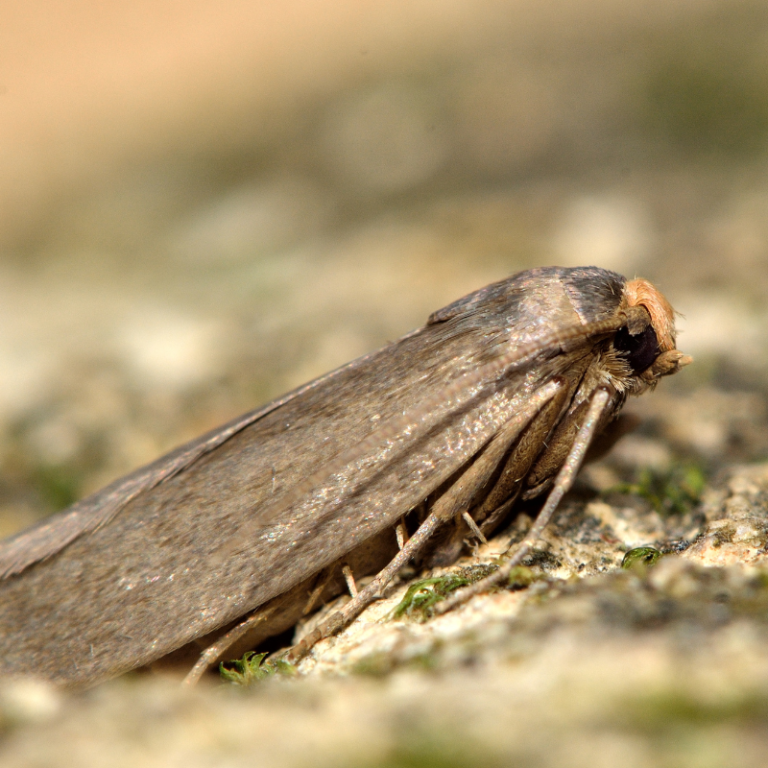
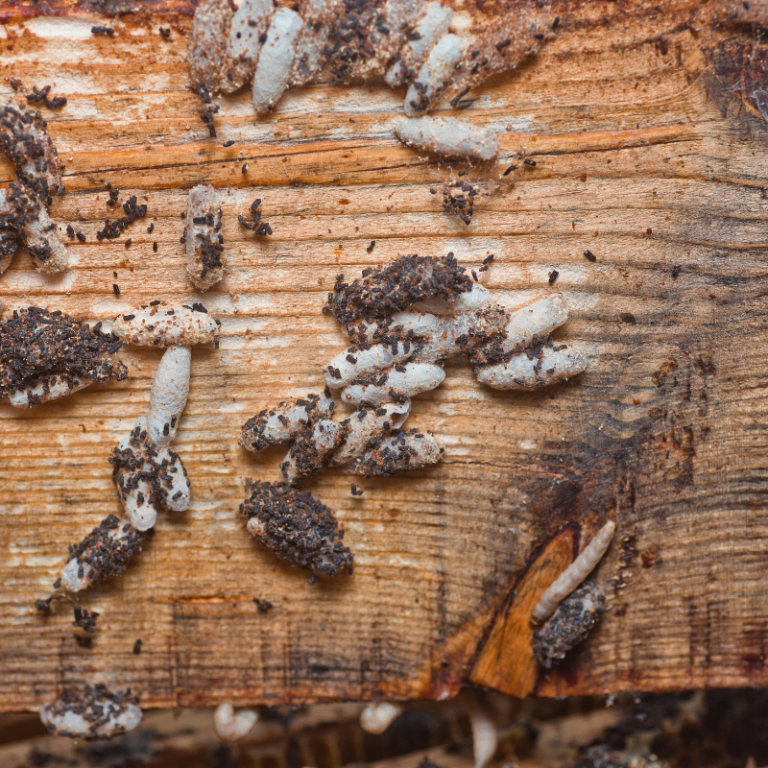
How Do I Know If I Have Wax Moths?
As mentioned before, an occasional wax moth is not a great concern, but if you open your hive and see a webby trail through your comb, you see clusters of cocoons, or you see vanilla-colored worms crawling in your brood frames, you have a problem. Bee larvae do not ever crawl around on the comb.
Small hive beetle larvae are often present at the same time. The difference is that these larvae are smaller, dozens can fit in a cell, and they leave oozing slime everywhere they’ve been.
Wax moth larvae are small at first but quickly grow bigger and spin webs through the comb. The bottom line is that if you see anything but adult bees crawling inside your hive, you need to look closer and diagnose the problem.
There is no wax moth treatment you can use to keep them from getting into the hive. Maybe one day, there will be a wax moth control, but usually, you need a healthy hive, and that is enough of a wax moth control.
What Should I Do If I See Wax Moths In My Beehive?
Things to look for and to do after noticing the presence of Wax Moths:
Do you see signs of disease or decline? (Nosema, Foul Brood, Chalkbrood or similar issues)
Have you checked for varroa mites recently? Foxhound Bee Company sells the Varroa Easy Check, a reliable way to determine your mite load.
Is there brood present? Can you find the Queen? If there are eggs present, then there was a queen at least recently. If not, and if the hive seems very weak, you might want to combine it with another hive.
You’ll want to check neighboring honey bee colonies for signs of infestation as well. Hopefully, you can catch them before the damage becomes irreversible.
If we open a colony, we will kill wax moth larvae with our hive tool when we can. You can’t kill wax moth eggs with a hive tool because you can’t see them.
Take out any frames that have moths in them and freeze them. Wax Moth larvae will die in the freezer, and the honey bees can repair the damage when you replace the frame.
Reduce the size of the hive so that it will be manageable for the bees who are left in the hive. This might mean you’ll have to feed them.
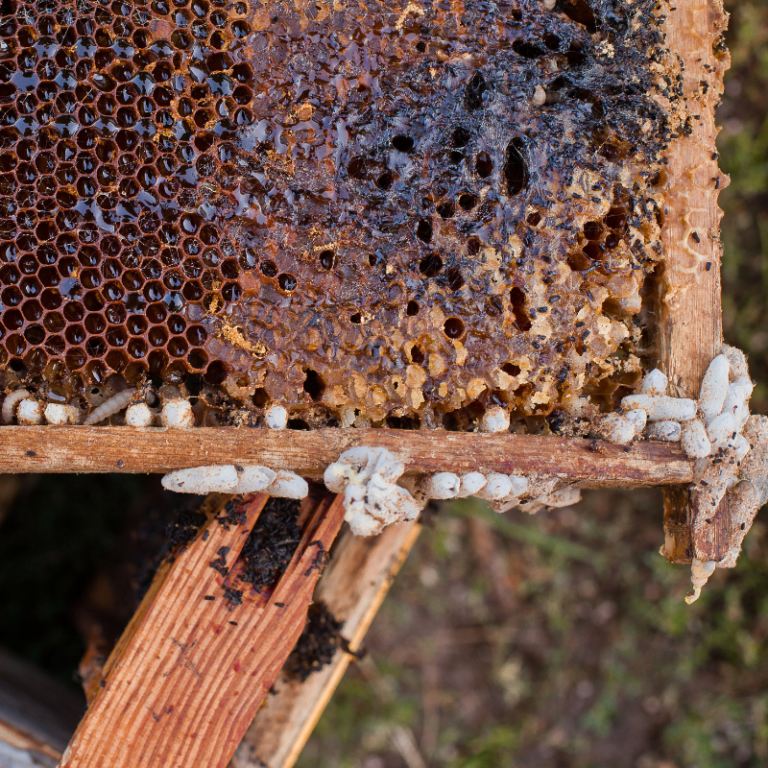

Varroa Mites and The Varroa Easy Check
Varroa Mites are insects that live in a honey bee colony and make it hard on bees to thrive. Well tell you what they are
Really Really Awful Infestations
If you open your hive and find wax moth cocoons, larva, and webbing all throughout the boxes, it’s really disheartening and gross. The wooden boxes, covers and bottom boards can be saved by just scraping the webbing and debris clean.
The frames can sometimes be saved depending on how bad the damage is. More on that is below. But before you can do anything with it, you have to deal with it in the bee yard.
You don’t want to put a box full of wax moth larvae and moths in your garage. A good practice is to take all the equipment and tilt it on it side.
You would lean each box on its short side so that light and wind can pass through the frames. But if it gets rained on, the water won’t collect in the comb.
We leave boxes like this for several days or weeks so the existing moths and larvae leave. We don’t want to bring that inside where we may have comb we are trying to protect.
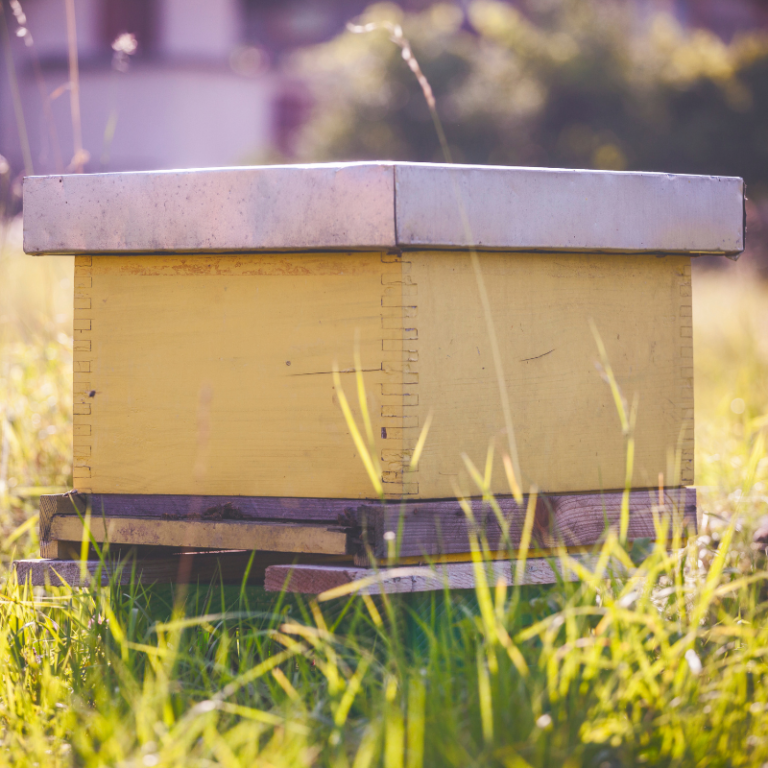
Can I Prevent Wax Moth Infestations?
Wax moths and wax moth larvae are part of nature, so they are a natural part of the life cycle of a beehive, but it is also natural for a beekeeper to want to deter them and save the bees with their hive! There are a few things you can do that could help.
Remember, the wax moth larva is after the comb where the queen has laid eggs. Wax moths are not very attracted to the comb that has only had honey in it.
Here is a great article from Clemson about Wax Moth IPM.
Moth Control In Live Honey Bee Colonies
The best thing is if the moths never get in your hive in the first place. When your bees are doing well, you will not see any moths, or you’ll see very few. If you check your hive often, you’ll notice the changes that may lead to an infestation of wax moths.
Don’t give the honey bees too much room. They can only protect their space if they have enough bees, so don’t give them more supers than they can manage, even if you have to take them down to a five-frame box.
If you see any evidence of wax moths, act quickly. Take out and freeze infested frames, check for diseases, and reduce the hive space if it seems like the bees have too much room.
Use a queen excluder to discourage the queen from laying eggs in the honey supers. This way, when you store your honey supers, they’ll be less attractive to the wax moths, who really want the brood comb for the extra protein.

Should You Use A Queen Excluder?
When, how and why to use a queen excluder is a common beginner beekeeper question and we can help you find out if a using
Moth Control In Stored Combs
It is devastating to pull your drawn comb out of storage only to find it full of webs, crumbling wax worm residue, and tunnels in the wooden frames. There are strategies you can try to prevent this loss.
Use wax moth crystals to prevent infestation during storage. Read the directions and always let the frames air out before putting them back on any beehives.
There is a product called Certan b402 bt — it is a bacteria that the beekeeper can spray onto the comb, and when larvae consume it, it kills them.
Certan has only recently become available in the United States (except California) for use on bee frames that are NOT IN THE HIVE as a preventative. Certan is reported to be non-toxic to bees.
Stack stored hive boxes with clean, dry frames inside so that they get light and air. Wax moths will not like light and air. It is a good idea to freeze the frames before you put them in storage, to ensure there aren’t any live pests going into storage with your precious built comb.
Read our blog about storing your equipment over winter: How to Store Beekeeping Equipment For Winter
Michael Hood, a researcher at Clemson, has found that storing equipment in a location with heavy fire ant activity can be an effective way to deter wax moths. The fire ants eat wax moth larvae.
What Can I Do About The Damage?
Wax moth damage can be quite a mess. If you use plastic foundation in your frames, you are in luck. You can clean up old comb on plastic foundation pretty well.
If moths do not eat all the wax, and there is enough left, you can freeze it and save it to process later (See our blog about Cleaning, Rendering, and Filtering Beeswax). You may need to brush another coat of beeswax onto the foundation to give the bees something to build upon.
Chickens can also help clean up the frames. They find the larvae to be a tasty snack and will make quick work of getting rid of the moths in damaged frames. They’ll even peck into the holes where wax moth cocoons are in the wooden pieces.
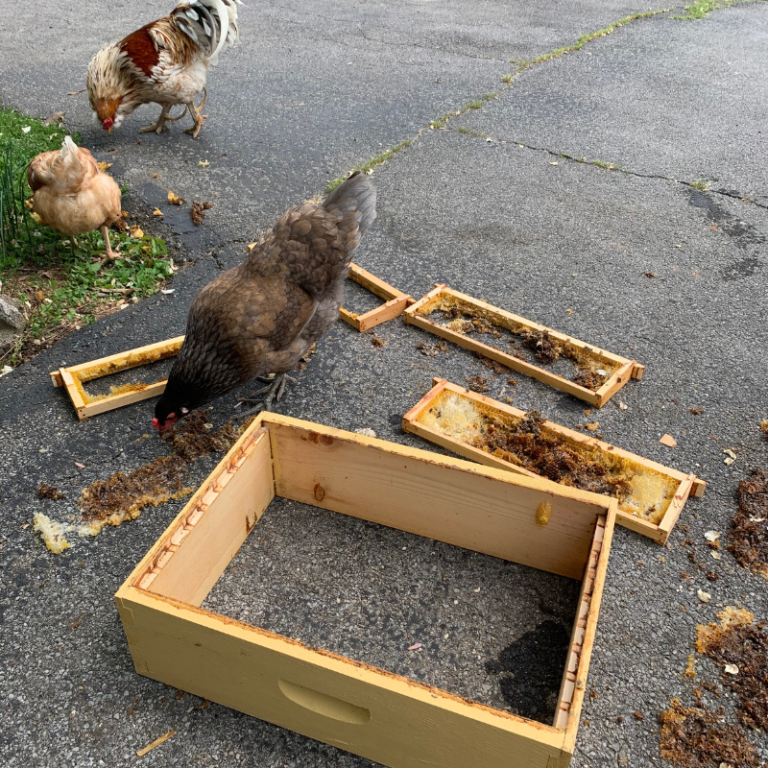
If there are a lot of deep holes left in your wooden ware from wax moth cocoons, you may decide to scrap it and start over. You don’t want to give hive beetles or future wax moths an easy hiding place. Whatever you do to remedy the damage, if you give the frames back to the bees, they’ll rebuild the comb.
Raising Wax Moths
While wax moths may not be welcome in your apiary, there are other uses for them that you may find interesting. Wax moth larvae are desirable as fish bait and as pet food for some exotic pets, like turtles, snakes, and birds. (I know from experience that chickens enjoy them)
The Beekeeper’s Handbook has an appendix dedicated to raising Wax moth larvae. They also report that delicately flavored, salted, and fried in oil, wax moths make a great snack that rivals potato chips or corn puffs. Let us know if you decide to try that!
Additional Information: Honey Bee Obscura podcast Dealing With Wax Moths



